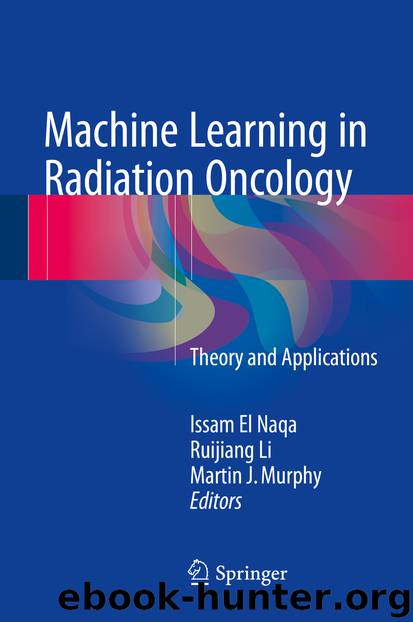Machine Learning in Radiation Oncology by Issam El Naqa Ruijiang Li & Martin J. Murphy

Author:Issam El Naqa, Ruijiang Li & Martin J. Murphy
Language: eng
Format: epub
Publisher: Springer International Publishing, Cham
9.3 Learning-Based Prostate Segmentation in CT and MR Images
9.3.1 Learning-Based Landmark Detection for Fast Prostate Localization in Daily Treatment CTs
In this section, we will introduce an application of boosting techniques in automatic landmark detection for fast prostate localization. Moreover, we will show how the accuracy of landmark detection and prostate localization can be further improved within the IGRT setting by adopting a novel method – namely, incremental learning with selective memory (ILSM) – to gradually incorporate the patient-specific information into the general population-based landmark detectors during the treatment course.
In the machine learning field, boosting refers to a technique which sequentially trains a list of weak classifiers to form a strong classifier [16]. One of the most successful applications of boosting is the robust real-time face detection method developed by Paul Viola and Michael J. Jones [16]. In their method, they combined Haar features with the boosting algorithm to learn a cascade of classifiers for efficient face detection. This idea can also be used to detect the anatomical landmark in medical images, which we call learning-based landmark detection. In such methods, the landmark detection is formulated as a classification problem. Specifically, for each image, voxels close to the specific landmark are positive and all others are negatives. In the training stage, the cascade learning framework is applied to learn a sequence of classifiers for gradually separating negatives from positives (Fig. 9.2). Compared to learning a single classifier, cascade learning has shown better classification accuracy and runtime efficiency [17, 18]. Mathematically, cascade learning can be formulated as:
Fig. 9.2Illustration of cascade learning
Download
This site does not store any files on its server. We only index and link to content provided by other sites. Please contact the content providers to delete copyright contents if any and email us, we'll remove relevant links or contents immediately.
| Administration & Medicine Economics | Allied Health Professions |
| Basic Sciences | Dentistry |
| History | Medical Informatics |
| Medicine | Nursing |
| Pharmacology | Psychology |
| Research | Veterinary Medicine |
Periodization Training for Sports by Tudor Bompa(7911)
Why We Sleep: Unlocking the Power of Sleep and Dreams by Matthew Walker(6347)
Paper Towns by Green John(4785)
The Immortal Life of Henrietta Lacks by Rebecca Skloot(4247)
The Sports Rules Book by Human Kinetics(4069)
Dynamic Alignment Through Imagery by Eric Franklin(3914)
ACSM's Complete Guide to Fitness & Health by ACSM(3816)
Kaplan MCAT Organic Chemistry Review: Created for MCAT 2015 (Kaplan Test Prep) by Kaplan(3795)
Introduction to Kinesiology by Shirl J. Hoffman(3619)
Livewired by David Eagleman(3531)
The River of Consciousness by Oliver Sacks(3412)
The Death of the Heart by Elizabeth Bowen(3333)
Alchemy and Alchemists by C. J. S. Thompson(3292)
Descartes' Error by Antonio Damasio(3161)
Bad Pharma by Ben Goldacre(3090)
The Gene: An Intimate History by Siddhartha Mukherjee(2920)
The Emperor of All Maladies: A Biography of Cancer by Siddhartha Mukherjee(2916)
The Fate of Rome: Climate, Disease, and the End of an Empire (The Princeton History of the Ancient World) by Kyle Harper(2863)
Kaplan MCAT Behavioral Sciences Review: Created for MCAT 2015 (Kaplan Test Prep) by Kaplan(2814)
